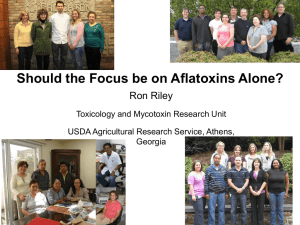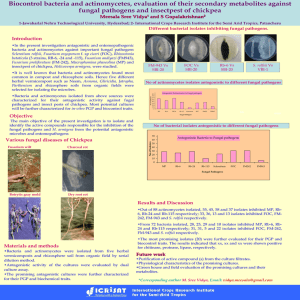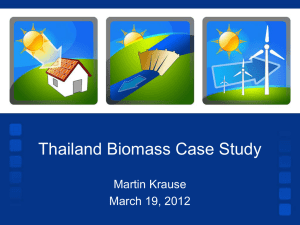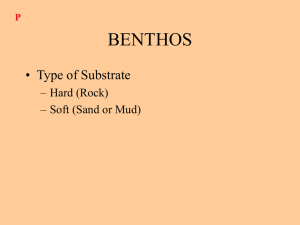Plant density field trial
advertisement
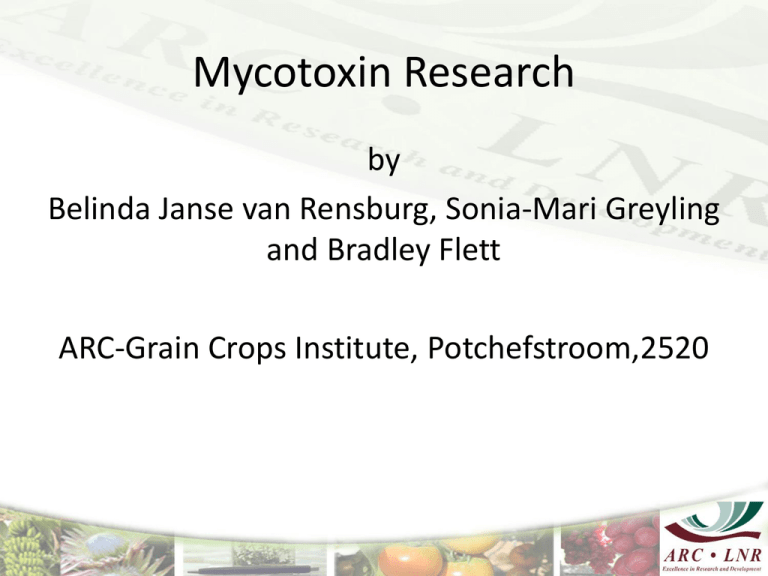
Mycotoxin Research by Belinda Janse van Rensburg, Sonia-Mari Greyling and Bradley Flett ARC-Grain Crops Institute, Potchefstroom,2520 Mycotoxin research team – ARC-GCI Prof. B. C. Flett - Mycotoxin Research Team Coordinator, resistance, screening, breeding, management practices (CA/conventional) Dr. B. Janse van Rensburg - Epidemiology, stressors, fungicides Ms. A. Schoeman - Isolate variation and interactions, molecular, FGSC, etiology Mr. E. Ncube - Bt technology, stem borers, subsistence farmers, storage facilities Collaborators: Stellenbosch University, Free State University, North West University, ARC-PPRI, ARC-OVI, PANNAR Seed Company, Cape Peninsula University of Technology, South African Sugar Research Institute, South African Grain Laboratories, University of Nairobi, Kenya, CIMMYT, Kenya, Partnership for Aflatoxin Control in Africa, Ethiopia, IITA, Nigeria and various individuals and institutions from Europe and the USA. Commodities: Maize, groundnuts, sorghum Fusarium verticillioides, F. proliferatum, F. subglutinans = fumonisins Fusarium graminearum species complex = zearalenone, nivalenol, deoxynivalenol Aspergillus flavus, A. parasiticus = aflatoxin Stenocarpella maydis = diplonine? Why are mycotoxins important? •Affect the entire chain of food and feed production •Reduction of marketable grain, increased cost of drying, decreased weight gain in animal feeding, fertility problems, and increased costs for animal health • Toxic to humans and animals • Restrict markets (for developing countries) Why are mycotoxins important? Techniques Mycotoxins ELISA replaced by: HPLC – fumonisin, aflatoxin, zearalenone, nivalenol, deoxynivalenol LC-MS – Stellenbosch University Fungal identification and quantification Identification and quantification by plating out replaced by: qPCR – probe (mycotoxin specific) , SYBR green (species specific) Plate out method to obtain fungal isolates. Sequencing, phylogenetics, SSH (population studies), tagging mycotoxins with fluorescent dye. PR Proteins: spectrophotometer, plate reader, RT-qPCR? Insect volatiles, insect repulsion/attraction studies Leaf nutrients (NWU laboratory) , soil analysis (ARC) The effect of maize plant stressors on Fusarium verticillioides and fumonisin production Dr. B. Janse van Rensburg Introduction - Substances or conditions that impose stress on the fungus also have an influence on mycotoxin production. - Not enough is known about the effect of plant stressors caused by high plant populations, drought, heat and N depletion on F. verticillioides growth and fumonisin production. - It is important to understand the effect of stressors on F. verticillioides and fumonisin production in order to reduce the risk of fumonisins on human and animal health. 1) 2) 3) 4) AIMS Determine the effect of drought stress on F. verticillioides infection and fumonisin contamination (glasshouse). To investigate the effect of plant density and nutrient availability on Fusarium ear rot, fumonisin producing Fusarium spp. infection and fumonisin contamination under field conditions. To investigate the effect of N fertilizer levels on the development of F. verticillioides infection and fumonisin contamination (glasshouse). Investigate the role of PR-proteins during fungal colonisation and fumonisin production. MATERIALS AND METHODS 1) Watering regime glasshouse trial: Glasshouse 9, 2012 and 2013 30ℓ-, 25ℓ-, 20ℓ-, 15ℓ- and 10ℓ-water per week, CRN3505 and PAN6P-110 planted in 80 ℓ black bags (x3 reps). Ears inoculated at silking. HPLC (toxin quantification), qPCR (fungal biomass). MATERIALS AND METHODS 2) Plant density field trial: ARC-GCI, 2011/12 and 2012/13. 10 000, 20 000, 30 000, 40 000 and 50 000 plants per ha of CRN3505 and PAN6P-110 (x3 reps). Soil analysis Gradual depletion of N from 2nd season onwards Leaves sampled and analysed for available N,C and S Hand harvested, HPLC, qPCR MATERIALS AND METHODS 3) N glasshouse trial: CRN3505 and PAN6P-110 were planted in 80 ℓ bags. KAN and UREA applied at the rates of 0kg-, 25kg-, 50kg-, 75kg- and 100kg-ha. Inoculated at silking Hand harvested HPLC, qPCR MATERIALS AND METHODS 4) PR-Proteins collected at: 8 leaf-, silking-, after inoculation , milk- and soft dough-stages. -1,3-glucanase, chitinase, peroxidase activity Chlorophyll fluorescence RESULTS 1) Watering regime glasshouse trial: - ANOVA – significant cv effect regarding fumonisin (P=0.00) - PAN6P-110 mean fum 4.04 ppm, CRN 3505 mean fum 7.72 ppm Means of HPLC 12.00 PAN6P-110 (cv1) CRN3505 (cv2) 9.00 Mean fumonisins (ppm) 6.00 3.00 0.00 1 cv 2 RESULTS 1) Watering regime glasshouse trial: - Watering regime (P=0.01) and cv (P=0.00) sign. for fungal biomass - Mean fungal biomass = 25.25 pg at 30 ℓ per week 45.12 pg at 15 ℓ per week - Significant watering regime x cv interaction (P=0.01) for fungal biomass qPCR mean (pg/µℓ) Watering regime RESULTS 1) Watering regime glasshouse trial: - Chlorophyll fluorescence data indicated PAN6P-110 to withstand plant-stress better than CRN3505 at some plant growth stages. plants/ha 50 000 plants/ha 40 000 plants/ha 30 000 plants/ha 20 000 plants/ha 10 000 cultivar - Plant density/ 2) - RESULTS Plant density field trial (2011-2012) and 4) PR-Proteins: Plant density had no effect on fungal biomass ANOVA indicated significant plant density effect regarding fumonisin (P=0.03) Sign. plant density x cv interaction regarding fumonisin (P=0.04) fumonisins fumonisins fumonisins fumonisins fumonisins PAN6P-110 1.47 2.79 3.20 3.66 16.65 5.55 CRN3505 0.49 2.93 3.11 3.83 2.40 2.55 Mean 0.98 2.86 3.15 3.75 9.53 -Regression analysis yielded Mean a significant relationship between fungal biomass and fumonisins (R2=0.73 and P=0.00). 2) - - - RESULTS Plant density field trial (2011-2012) and 4) PR-Proteins: Plant density - significant effect on: Peroxidase - 8 leaf stage (P=0.01) Peroxidase activity 111 273 nmol guaicol. mg-1 protein. min -1 at 10 000 plants/ha Peroxidase activity 156 667 nmol guaicol. mg-1 protein. min -1 at 50 000 plants/ha Peroxidase - silking stage (P=0.00) Peroxidase activity 18 339 nmol guaicol. mg-1 protein. min -1 at 10 000 plants/ha Peroxidase activity 97 598 nmol guaicol. mg-1 protein. min -1 at 50 000 plants/ha Chitinase during plant silk stage (P=0.02) 0.26 A550 nm. mg-1 protein. min-1 at 10 000 plants/ha 0.29 A550 nm. mg-1 protein. min-1 at 50 000 plants/ha RESULTS 2) Plant density field trial (2011-2012) and leaf nutrients - Plant density had a significant effect on available N (P=0.00) and C (P=0.00) in maize leaves: 8 leaf stage, silk stage, milk stage, and soft dough stage. 10 000 plants/ha 50 000 plants/ha N - 8 leaf stage 3.63% 3.16% N - silk stage 2.97% 2.28% N - milk stage 7.28% 2.13% N - soft dough stage 6.08% 1.23% C - 8 leaf stage 43.58% 43.46% C - silk stage 43.14% 43.04% C - milk stage 40.16% 35.91% C - soft dough stage 40.12% 35.12% Performance index parameters of PAN6P-110 and CRN3505 measured during three plant growth stages, applying five different plant densities. 1) - - DISCUSSION Watering regime glasshouse trial: Fungal biomass is not a direct reflection of fumonisin synthesis, this could explain why watering regime did not significantly effect fumonisin. Inoculation could have attributed to the significant water regime x cultivar effect regarding fungal biomass. Trial repeated 2) Plant density field trial: - Plant density had no effect on fungal biomass possibly due to natural infection of plants. - Significant higher fumonisin levels at increased plant densities could be attributed to “stress” factors such as competition for water and nutrients. DISCUSSION 2) - Plant density field trial (continued): Low temperature and water stress reduce fungal growth. Increased water stress increases FUM 1 expression. This could explain significantly higher fumonisin levels in increased plant densities although fungal biomass did not increase. CRN3505 - lower fungal biomass and fumonisins compared to PAN6P-110. Potchefstroom, Bethlehem and Ermelo (2013/14) to determine possible cultivar x environmental conditions. Peroxidase and chitinase (silking) – important stages for fungal infection and fumonisin synthesis. More N available at lower plant densities. Relevance and importance to the maize industry - Management of Fusarium spp. and mycotoxins is reliant on an integrated system. - One of the components in such an integrated system is to limit plant stressors. - Literature available, but paucity of work to determine effect of stressors on fungal infection and mycotoxin synthesis under local conditions. - For example: increase in fumonisins at higher plant populations with an added cultivar effect. - Assist with management decisions. - Applied by small scale and commercial producers. Prof. B. C. Flett - FlettB@arc.agric.za Dr. B. Janse van Rensburg - BelindaJ@arc.agric.za Dr. J. Berner - jacques.berner@nwu.ac.za Ms. A. Schoeman - BelgroveA@arc.agric.za Mr. E. Ncube - NcubeE@arc.agric.za Tel: 018 299 6100
